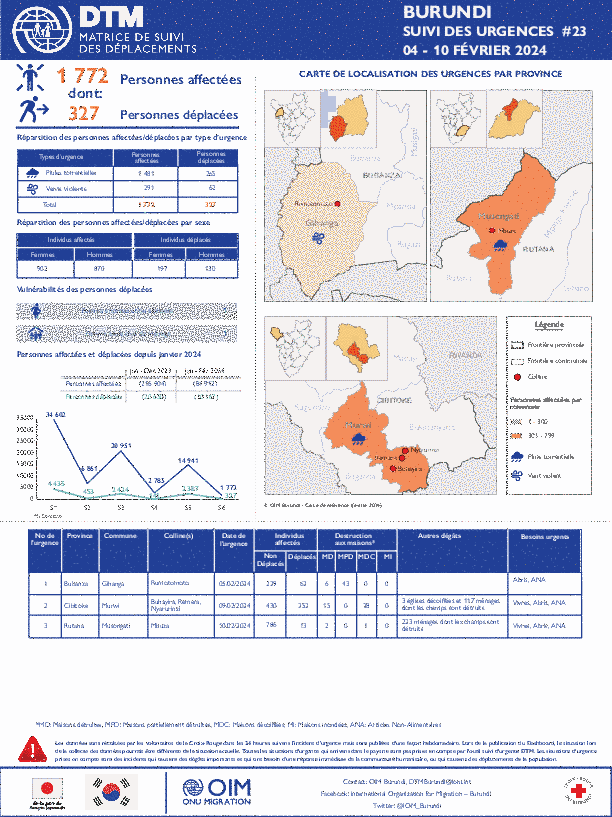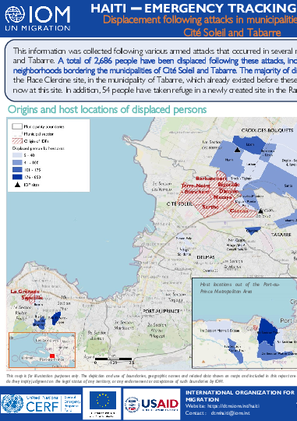-
Countries
-
Data and Analysis
-
Special Focus
-
Crisis Responses
Event Tracking
Contact
DTM Yemen, iomyemendtm@iom.int
Location
Yemen
Activity
- Mobility Tracking
- Event Tracking
Period Covered
Feb 11 2024 -Feb 17 2024
From 1 January to 17 February 2024, IOM Yemen DTM tracked 496 households (HH) (2,976 Individuals) who experienced displacement at least once.
Between 11 and 17 February 2024, IOM Yemen DTM tracked 36 households (216 individuals) displaced at least once. The majority of people moved into/within the following governorates and districts:
- Ma’rib (20 HHs) – Ma’rib City (9 HHs), Ma’rib (8 HHs), Harib (3 HHs) districts. Most displacements in the governorate originated from Ma’rib and Sanaa.
- Al Hodeidah (7 HHs) – Hays (6 HHs), Al Khukhah (1 HHs) districts. Most displacements in the governorate were internal.
- Ta’iz (4 HHs) – Maqbanah (3 HHs), Al Qahirah (1 HHs) districts. All displacements in the governorate were internal.
The majority of people moved from the following governorates and districts:
- Al Hodeidah (9 HHs) – Hays (6 HHs), At Tuhayta (2 HHs), Al Qanawis (1 HHs) districts.
- Ta’iz (8 HHs) – Maqbanah (5 HHs), Sharab As Salam (2 HHs), Sabir Al Mawadim (1 HHs) districts.
- Ma’rib (7 HHs) – Harib (6 HHs), Majzar (1 HHs) districts.
Population Groups
Survey Methodology
Unit of Analysis Or Observation
Type of Survey or Assessment
Keywords
Geographical Scope
Administrative boundaries with available data
The current dataset covers the following administrative boundaries

Contact
DTMMozambique@iom.int
Language
English
Location
Mozambique
Period Covered
Feb 08 2024
Feb 16 2024
Activity
- Mobility Tracking
- Event Tracking
Although included within this cumulative displacement estimate- the current Movement Alert #98 reports on recent attacks recorded in Macomia, Chiure and Mecu¬ between 8 to 16 February that displaced 4,212 individuals. Within this reporting period, arrivals of displaced families have been mapped across villages of Ancuabe, Macomia, Chiure, Muidumbe, Quissanga, Metuge, Montepuez, Mecufi¬, Erati and Ibo.
Of the total individuals displaced between 8-16 February, 249 families with 900 individuals have taken refuge in displacement centres of Chiure (Maningane, Muajaja, and Namisir) 143 families with 424 individuals have taken refuge in displacement centres of Macomia (Nanga A and Nanga B), 15 families with 64 individuals have taken refuge in displacement centre of Montepuez (Ntele), 18 families with 72 individuals have taken refuge in displacement centre of Metuge (Ngunga), 10 families with 19 individuals have taken refuge in displacement centre of Muidumbe (Lutete) 2 families with 16 individuals have taken refuge in displacement centre of Mueda (Lyanda) and 3 families with 8 individuals have taken refuge in displacement centres of Ancuabe (Cujupane, Nanjua).

Contact
DTMCostaRica@iom.int
Language
English
Location
Costa Rica
Period Covered
Jan 01 2024
Jan 30 2024
Activity
- Flow Monitoring
- Mobility Tracking
- Event Tracking
Cantons: Alajuela, Cartago, Corredores, Desamparados, Heredia, Liberia, Los Chiles, San Carlos, San José, Santa Ana y Tibás
Costa Rica, like the other countries in the Central American region, has been characterized as a migratory corridor for people who transit by land from the south to the north of America and whose destination is the countries in the north of the continent. This flow on the move through the Americas is mainly made up of people from the Bolivarian Republic of Venezuela, Cuba, Haiti, Ecuador, as well as people from other countries in South America, Africa and Asia.
According to estimations from IOM Costa Rica, during December 37,436 people entered the country, an approximate average of 1,208 people per day and estimating a increase of 30% compared to December 2023. In addition, 1,407 people stranded in the monitored shelters were identified and 732 people stranded in the public places visited.

Contact
DTMMozambique@iom.int
Language
English
Location
Mozambique
Period Covered
Feb 08 2024
Feb 14 2024
Activity
- Mobility Tracking
- Event Tracking
Between 22 December to 12 February, a series of sporadic attacks and fear of attacks by Non-state Armed Groups in Macomia, Chiure, Mecufi, Mocimboa da Praia, and Muidumbe triggered the cumulative displacement 12,963 individuals/2,047 families.
Although included within this cumulative displacement estimate- the current Movement Alert #97 reports on recent attacks recorded in Macomia, Chiure and Mecufi between 8 to 14 February that displaced 2,114 individuals. Within this reporting period, arrivals of displaced families have been mapped across villages of Ancuabe, Macomia, Chiure, Muidumbe, Quissanga, Metuge, Montepuez, Mecufi, Erati and Ibo.
Of the total individuals displaced between 8-14 February, 128 families with 348 individuals have taken refuge in displacement centers of Macomia (Nanga A and Nanga B), 190 families with 676 individuals have taken refuge in displacement centers of Chiure (Maningane, Muajaja, and Namisir), 15 families with 64 individuals have taken refuge in displacement centers of Montepuez (Ntele), 17 families with 68 individuals have taken refuge in displacement centers of Metuge (Ngunga), 2 families with 16 individuals have taken refuge in displacement centers of Mueda (Lyanda) and 3 families with 8 individuals have taken refuge in displacement centers of Ancuabe (Cujupane, Nanjua).

Contact
DTM DRC, iomdrcdtm@iom.int
Language
French
Location
Democratic Republic of the Congo
Period Covered
Jan 28 2024
Feb 12 2024
Activity
- Mobility Tracking
- Event Tracking
Depuis 2022, la région orientale de la République démocratique du Congo (RDC), en particulier le Nord-Kivu, est en proie à un conflit dévastateur qui s'est intensifié et est devenu de plus en plus complexe au fil du temps, avec le potentiel d'atteindre des niveaux sans précédent dans le Nord-Kivu. Cette crise se caractérise par une multitude d'acteurs armés en conflit, une importante population déplacée et une population encore plus importante en manque d'aide humanitaire. Le conflit actuel entre le groupe M23 et les Forces armées de la République démocratique du Congo (FARDC) et leurs alliés a été une source majeure de violence et d'instabilité dans la région.
La période allant du 28 janvier au 12 février 2024 est particulièrement caractérisée par une expansion des hostilités dans les territoires de Masisi en chefferie , Rutshuru et Nyiragongo. Les endroits les plus touchés dans le Masisi sont les chefferies Bashali et Bahunde, le groupement Bukombo dans le Rutshuru et les groupements Buhumba et Kibumba dans le Nyiragongo.
Depuis le début de la crise, l'OIM, par le biais de la DTM continue à mener une série d'évaluations rapides, y compris le suivi des urgences (EET/ERM), l'analyse des crises et enregistrement avec priorité de répondre aux besoins immédiats d'information en vue de comprendre la dynamique des déplacements et les besoins. Ce rapport présente les résultats des évaluations menées dans les différentes zones de déplacement et de retour du 28 janvier au 12 février 2024.

Contact
DTM DRC, iomdrcdtm@iom.int
Language
English
Location
Democratic Republic of the Congo
Period Covered
Jan 28 2024
Feb 12 2024
Activity
- Mobility Tracking
- Event Tracking
Since 2022, the eastern region of the Democratic Republic of Congo (DRC), in particular North Kivu, has been gripped by a devastating conflict that has intensified and become increasingly complex over time, with the potential to reach unprecedented levels in the province.
The period from 28 January to 12 February 2024 was particularly marked by an expansion of hostilities in the territories of Masisi, Rutshuru and Nyiragongo. The most affected areas identified are located in Masisi (the Bashali and Bahunde chefferies), the Bukombo groupement in Rutshuru and the Buhumba and Kibumba groupement in Nyiragongo.
Since the beginning of the crisis, IOM, through its Displacement Tracking Matrix (DTM), has continued conducting a series of rapid assessments, including emergency monitoring (EET/ERM), crisis analysis and registration with the aim of responding to immediate information needs in order to understand displacement dynamics.
This report presents the results of assessments carried out in the various displacement and return areas between 28 January and 12 February 2024.

Contact
DTM Burundi, DTMBurundi@iom.int
Language
English
Location
Burundi
Period Covered
Feb 04 2024
Feb 10 2024
Activity
- Mobility Tracking
- Event Tracking
La DTM a identifié 1,772 personnes affectées, dont 327 personnes déplacées par les pluies torrentielles et les vents violents dans les provinces de Rutana, Cibitoke et Bubanza

Contact
dtmhaiti@iom.int
Language
English
Location
Haiti
Period Covered
Feb 07 2024
Feb 13 2024
Activity
- Mobility Tracking
- Event Tracking
This information was collected following various armed attacks that occurred in several neighborhoods of the capital since 5 February, in the municipalities of Carrefour, Cité Soleil and Tabarre. This report is an update of the one published on 11 February and other updates will be published depending on the evolution of displacement. A total of 9,901 people have been displaced following these attacks, including 7,261 following attacks in neighborhoods bordering the municipalities of Cité Soleil and Tabarre as well as 2,640 following those in the municipality of Carrefour. Most of these people (90%) took refuge in areas located in the West district and the rest left for provinces, notably towards Nippes (5%) and Center (3%). The majority (63%) took refuge with host families and 37% in 13 sites (all located in the Port-au-Prince Metropolitan Area, in the West district), including 3 sites which already existed before these incidents and 10 newly created
Between 22 December to 12 February, a series of sporadic attacks and fear of attacks by Non-state Armed Groups in Macomia, Mecufi, Mocimboa da Praia, and Muidumbe triggered the cumulative displacement 10,849 individuals/1,478 families.
Although included within this cumulative displacement estimate- the current Movement Alert #96 reports on recent attacks recorded in Macomia, Chiure and Mecufi between 8 to 12 February that displaced 812 individuals. Within this reporting period, arrivals of displaced families have been mapped across villages of Macomia, Chiure, Metuge, Montepuez, Mecufi, Erati and Ibo.Of the total individuals displaced between 8-12 February, 47 families with 139 individuals have taken refuge in displacement centers of Macomia (Nanga A and Nanga B), 35 families with 108 individuals have taken refuge in displacement centers of Chiure (Maningane, Muajaja, and Namisir), 10 families with 45 individuals have taken refuge in displacement centers of Montepuez (Ntele), and 2 families with 22 individuals have taken refuge in displacement centers of Metuge (Ngunga).

Contact
dtmhaiti@iom.int
Language
English
Location
Haiti
Period Covered
Feb 07 2024
Feb 11 2024
Activity
- Mobility Tracking
- Event Tracking
This information was collected following various armed attacks that occurred in several neighborhoods of the capital since 05 February, in the municipalities of Carrefour, Cité Soleil and Tabarre. A total of 2,686 people have been displaced following these attacks, including 1,819 following attacks in the municipality of Carrefour and 867 following those in neighborhoods bordering the municipalities of Cité Soleil and Tabarre. The majority of displaced populations (94%) took refuge with host families and 6% in two sites (100 people at the Place Clercine site, in the municipality of Tabarre, which already existed before these incidents and 380 people were already accommodated there. Thus, around 480 people are now at this site. In addition, 54 people have taken refuge in a newly created site in the Ramoth de Marin school in the municipality of Croix-Des-Bouquets).
Pagination
- Previous page
- Page 45
- Next page
